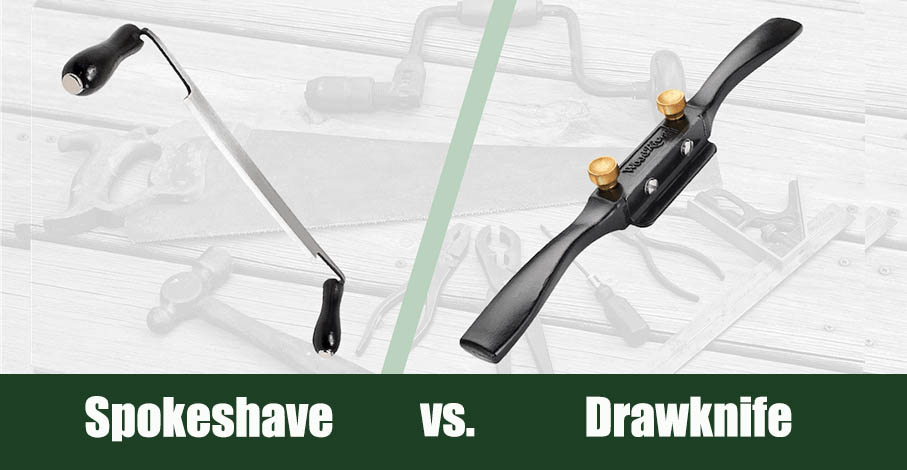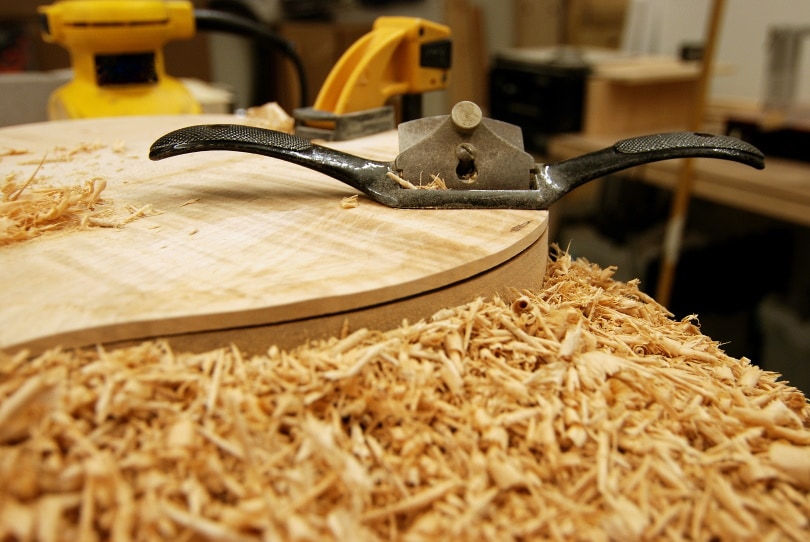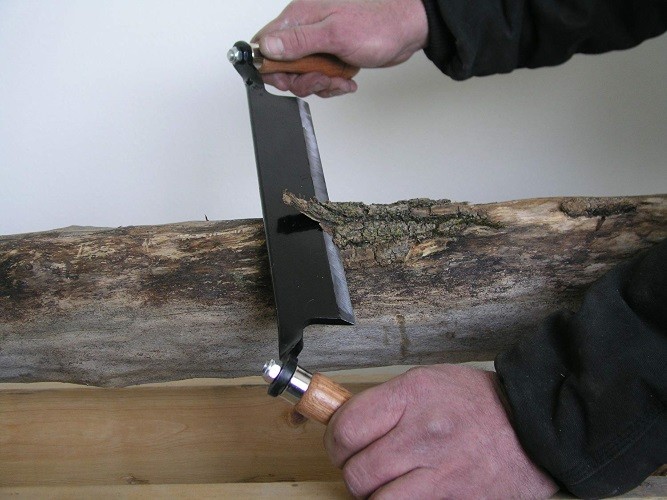Spokeshave vs Drawknife: What’s the Difference?
-
- Last updated:


There are some tools that are so different in both form and function that choosing between them is an obvious no-brainer (think a saw vs. a hammer). Unfortunately, that is not the case for the spokeshave and drawknife. They are incredibly similar and can sometimes be used interchangeably.
Nonetheless, there is a difference between the two tools. Notably, the spokeshave is much smaller than the drawknife, making it better for more delicate or specific jobs. Still, the difference between the two is subtle and warrants more discussion. Let’s take a closer look at the spokeshave and drawknife to determine their differences.

Overview of Spokeshaves

The spokeshave is a woodworking tool that involves a blade and handles. The tool is relatively small, and the blade between the two handles is shorter. This causes the handles for both your right and left hands to be closer together.
In many ways, the handles on the spokeshave look like they extend from the blade like a pair of wings. Besides looking cool, this design helps the spokeshave make fine and controlled cuts. Although spokeshaves can come in many sizes, they are almost always smaller than the drawknife.
Additionally, there are different types of spokeshaves. You will have your choice between a flat, concave, or convex blade and a flat, concave, or convex sole.
How to Use
Since the spokeshave has smaller handles, you will hold each handle between your first two fingers on each hand. The thumb should be behind the blade. Place the sole against the wood you’re working on, and pull the spokeshave toward you. Give the tool a slight downward pressure to make the work more balanced. You can also push a spokeshave instead of pulling it.
Benefits
Because of the smaller size of most spokeshaves, they are best for small details or designs. For example, they are great for chair legs, spokes, or paddles. Though the tool does not go cut deep, it is beneficial because of how delicate and detail-oriented it can be.
Drawbacks
The drawback of the spokeshave is that you can’t cut big pieces out of the log. It is not designed to make big cuts and can only be used for detailed work.
Best For
Due to the spokeshave’s more delicate and detailed nature, it is best for intricate projects. It’s beneficial if you find detailed work to be a challenge. The small frame of the spokeshave will make it much easier to get into the crevices without damaging the wood.
- Easy to use
- Great for detail work
- Not suitable for large cuts

Overview of Drawknives

The drawknife includes two handles and a blade between the handles. Many people think that drawknives look similar to handlebars on a bicycle. Depending on the task, the blade can be straight or curved. Either way, you can thinly slice wood or remove large chunks. Drawknives are often used for debarking trees, trimming beams, and shaping wooden sculptures.
Since drawknives are suitable for removing thin slices and big chunks, you will sometimes hear the tool called an “all-rounder.”
How to Use
How you use the drawknife is suggested in the name. You will place the drawknife on the wood you are working on. It is best to place it at an angle. Then, you pull or draw the tool towards your body. This allows for the slices of wood to come off the log quickly.
You could use the drawknife in two ways: bevel up or bevel down. Using the tool bevel up gives you more control, which makes it easier to create finer shavings or deeper cuts. Conversely, beveling down prevents you from cutting too deep. This is great for hollowing out pieces, but it dulls the blade.
Benefits
The benefit of the drawknife is its versatility. Whether you need to slice a log or take off a large chunk, the drawknife can do it. This makes it a highly versatile tool for almost all commercial woodworking purposes.
Drawbacks
The drawback of the drawknife is that it is difficult to use. Especially if you want to use it for more fine or detailed work, you must know how to use the tool beforehand. If not, you could injure yourself or butcher the wooden log.
Best For
Drawknives are best for professional woodworkers. Since they are challenging to use, they require the experience and care of a professional.
- Versatile
- Good for cutting big chunks
- Good for thin slices
- More difficult to use
What’s the difference?
| Spokeshave | Drawknife | |
| Ease of use | Easy to use | Difficult to use |
| Control over cuts | High control | Low control |
| Depth control | High control | Low control |
| Tool movement | Push and pull | Pull only |
| Blade design | Slotted sole | Handles |
| Best for | Delicate detail work | Quick and easy cuts; versatile use with experience |
For the most part, spokeshaves and drawknives have very similar designs, except the smaller frame of the spokeshave. Most of the differences between these two tools lie in their function, not necessarily the design.
Control Over Cuts
Spokeshaves give you more control over your cuts. This makes them better for detailed work. On the other hand, drawknives give you less control and are better suited for rough cuts. The rougher cuts make them great if you need to get a job done fast and don’t care about the appearance.
Depth Control
Depth control is another big area of difference between these two tools. A spokeshave will give you more depth control since they are smaller. The smaller frame means cutting too much off the wood log will naturally be more difficult. A drawknife, in contrast, gives you minimal depth control, requiring a bit of a learning curve when working with the tool.
Tool Movement
How you move the two tools differs as well. A spokeshave can both be pulled towards you or pushed away from you. Drawknives can only be pulled.
Blade Design
The last area of difference between these two tools is the blade. A spokeshave blade is designed to fit into a slotted sole. The blade on the drawknife is simply supported by the handles, giving it a handlebar shape.
Which should you get?
At this point, you may be wondering, “Which tool should I get?” The answer depends on the job you are working on and your experience level.
Job
The job you are working on will largely determine which tool to use. It will probably be best to go with the spokeshave for delicate detail work. Its design will make it much easier to create delicate shapes that are beautiful from start to finish.
If you need to make rough cuts on the go, the drawknife is your best bet. If you don’t care too much about the appearance, the drawknife will do the job efficiently and quickly.
Experience Level
Your experience level is another factor you should consider. Though highly efficient, drawknives can be more difficult to use if you don’t have the experience. If you are a beginner, you might want to select a spokeshave. You will benefit from the more controlled design with a spokeshave, even though it may take longer.
Professionals might want both tools. The drawknife will give you a versatile and convenient tool for making delicate and larger cuts, while the spokeshave helps you make delicate design details that your drawknife simply can’t do.

Quick Look: Our Top Choices
| Image | Product | Details | |
|---|---|---|---|
Our Favorite Spokeshave
 |
STANLEY Spokeshave |
|
CHECK PRICE |
Our Favorite Drawknife
 |
Timber Tuff TMB-08DS Straight Draw Shave Tool |
|
CHECK PRICE |
Our Favorite Spokeshave: STANLEY Spokeshave

The STANLEY Spokeshave is a durable, efficient, and easy-to-use tool. It is designed for curved work, such as when you are shaping a chair seat. The cutters are designed to be adjusted according to the depth of cut and thickness for the job.
The tool has a flat base for both flat and convex surfaces, making it more versatile. It also comes with a vinyl pouch for easy and safe storage. STANLEY backs the product with a limited lifetime warranty.
Our Favorite Drawknife: Timber Tuff TMB-08DS Straight Draw Shave Tool

This Timber Tuff Drawknife includes a sharp 8-inch straight blade that is 5 millimeters thick and angled at 30 degrees. This provides fast and accurate work. The blade is also made of steel, ensuring it is durable and long-lasting. Meanwhile, the handles are made of wood so that you can have a comfortable yet secure hold. The Timber Tuff comes with a 1-year limited manufacturer’s warranty.

Conclusion
Even though some experts may be able to use spokeshaves and drawknives interchangeably, the two tools are different. Spokeshaves are better for more delicate work, while drawknives are better for rougher cuts. Professionals will be wise to get both tools because of their different functions and benefits.
See also:
- CANT HOOK VS PEAVEY: WHAT’S THE DIFFERENCE?
- ARCAN VS PITTSBURGH FLOOR JACKS: WHICH IS BETTER?
- BRUSH CUTTER VS CLEARING SAW: WHAT’S THE DIFFERENCE?
Contents


